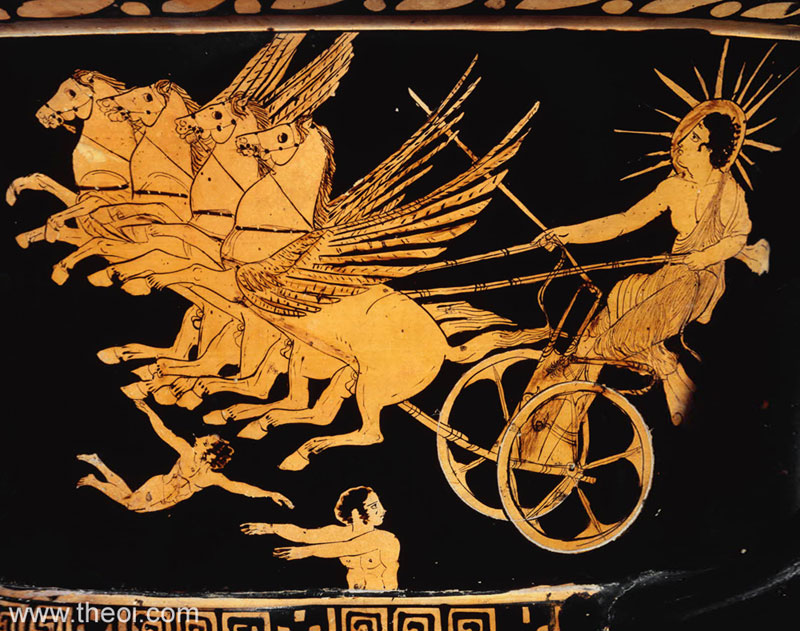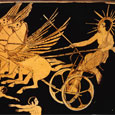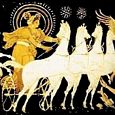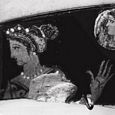ASTRA PLANETA
Greek Name
Αστηρ Πλανητων
Αστρα Πλανητα
Transliteration
Astêr Planêtôn,
Astra Planêta
Roman Name
Stella Errante
Stellae Errantae
Translation
Wandering Stars,
Planets

THE ASTRA PLANETA were the gods of the five wandering stars. They were named Phainon (planet Saturn), Phaethon (planet Jupiter), Pyroeis (planet Mars), Eosphoros (planet Venus) and Stilbon (planet Mercury).
In ancient Greek vase painting they were depicted as youths diving into the earth-encircling river Okeanos (Oceanus) before the rising chariot of the sun-god Helios.
The three remaining planets--Uranus, Neptune and Pluto--are invisible to the naked eye and were only discovered and named in modern times.
FAMILY OF THE PLANETA
PARENTS
[1] ASTRAIOS & EOS (Hesiod Theogony 378, Apollodorus 1.8)
[2] NYX (Orphic Hymn 7)
NAMES
[1] EOSPHOROS, PYROEIS, STILBON, PHAINON, PHAITHON (Hyginus Astronomica 2.42, Cicero De Natura Deorum 2.20)
CLASSICAL LITERATURE QUOTES
PARENTAGE OF THE ASTRA PLANETA

Hesiod, Theogony 378 ff (trans. Evelyn-White) (Greek epic C8th or C7th B.C.)
:
"And Eos (Dawn) bare to Astraios (Astraeus, the Starry) the strong-hearted Anemoi (Winds) . . . a goddess
mating in love with a god. And after these Erigenia [Eos] bare the star Eosphorus (Dawn-bringer), and the
gleaming Astra (Stars) with which heaven is crowned."
Pseudo-Apollodorus, Bibliotheca 1. 8 - 9 (trans. Aldrich) (Greek mythographer C2nd
A.D.) :
"The Titanes (Titans) had children . . . Eos and Astraios (Astraeus) were parents of Anemoi (Winds) and
Astra (Stars)."
PLANETA THE GODS OF THE FIVE WANDERING-STARS
Plato, Cratylus 400d & 409c (trans. Lamb) (Greek philosopher C4th B.C.)
:
"[Plato constructs philosophical etymologies for the names of the gods.]
Sokrates (Socrates) : Let us inquire what thought men had in giving them [the gods] their names . . . The first
men who gave names [to the gods] were no ordinary persons, but high thinkers and great talkers . . . But why
should you not tell of another kind of gods, such as sun, moon, stars, earth, ether, air, fire, water, the
seasons, and the year? . . . I think the stars (astera) get their name from astrapê
(lightning). But astrapê, because it turns our eyes upwards (ta ôpa anastrethei),
would be called anastrôpê, which is now pronounced more prettily
astrapê."
Apollonius Rhodius, Argonautica 1. 498 ff (trans. Rieu) (Greek epic C3rd B.C.)
:
"He [Orpheus] sang of [the creation of the cosmos] . . . how the Astra (Stars), Selene (Moon), and
travelling Helios (Sun) keep faithfully to their stations in the heavens."
Aratus, Phaenomena 454 ff (trans. Mair) (Greek astronomical poem C3rd B.C.)
:
"But of quite a different class are those five other orbs [the Planetoi (Planets)], that intermingle with
them and wheel wandering on every side of the twelve figures of the Zodiac. No longer with the others as they
guide couldst thou mark whee lies the path of those, since all pursue a shifty course, and long are the periods
of their revolution and far distant lies the goal of their conjunction."
Philostratus the Elder, Imagines 1. 11 (trans. Fairbanks) (Greek rhetorician C3rd
A.D.) :
"[From a description of an ancient Greek painting depicting the fall of Phaethon :] In his passion for
driving this son of Helios (the Sun) [Phaethon] ventured to mount his father's chariot, but because he did not
keep a firm rein he came to grief and fell into the Eridanos . . . Look! Nyx (Night) is driving Hemera (Day)
from the noonday sky, and the Sun's orb as it plunges toward the earth draws in its train the Astera (Stars)
[i.e. the five Planeta]."
Orphic Hymn 7 to the Stars (trans. Taylor) (Greek hymns C3rd B.C. to 2nd A.D.)
:
"To the Astron (Stars) [both the fixed stars and the planets], Fumigation from Aromatics. With holy voice I
call the stars on high, pure sacred light, and Daimones of the sky. Celestial stars, dear progeny of Nyx
(Night), in whirling circles beaming far your light; refulgent rays around the heavens ye throw, eternal fires,
the source of all below. With flames significant of fate ye shine, and aptly rule for men a path divine. In
seven bright zones ye run with wandering flames, and heaven and earth compose your lucid frames: with course
unwearied, pure and fiery bright, for ever shining through the veil of Nyx (Night). Hail, glittering, joyful,
ever wakeful fires! Propitious shine on all my just desires, these sacred rites regard with conscious rays, and
end our works devoted to your praise."
Anonymous, Hero and Leander Fragment (trans. Page, Vol. Select Papyri III, No. 126)
(Greek poetry C3rd to 1st B.C.) :
"‘Stars (asteres), bow to my prayer, and become sightless; Moon (mênê),
suffer your light to sink swiftly and depart!’ So she [Hero] spoke, for to see Laandros (Leander) was all
her heart's desire. Then did he too make supplication : ‘Back, Hesperos [i.e. the star Venus], to
hiding!’--thus prayed Laandros--‘Ride backward, all the stars, that night and heaven and sun and
earth may grow dark!’"
Pseudo-Hyginus, Astronomica 2. 4 (trans. Grant) (Roman mythographer C2nd A.D.)
:
"Planets. It remains for us to speak of the five stars which many have called wandering, and which the
Greeks call Planeta.
One of them [the planet Jupiter] is the star of Jove [Zeus], Phaenon by name, a youth whom Prometheus made
excelling all others in beauty, when he was making men, as Heraclides Ponticus says. When he intended to keep
him back, without presenting him to Jove as he did the others, Cupid [Eros] reported this to Jove, whereupon
Mercurius [Hermes] was sent to Phaenon and persuaded him to come to Jove and become immortal. Therefore he is
placed among the stars.
The second star [the planet Saturn] is that of Sol [Helios]; others say of Saturnus [Kronos (Cronus)].
Eratosthenes claim that it is called Phaethon, from the son of Sol. Many have written about him--how he
foolishly drove his father's chariot and set fire to the earth. Because of this he was struck with a thunderbolt
by Jove, and fell into the river Eridanus, and was conveyed by Sol to the constellations.
The third star [the planet Mars] is that of Mars [Ares], though others say it belongs to Hercules . . . Since
she [Aphrodite] inflamed him violently with love, she called the star Pyroeis, indicating this fact.
The fourth star [the planet Venus] is that of Venus [Aphrodite], Luciferus [Eosphoros] by name. Some say it is
Juno's [Hera's]. In many tales it is recorded that it is called Hesperus, too. It seems to be the largest of all
stars. Some have said it represents the son of Aurora [Eos] and Cephalus, who surpassed many in beauty, so that
he even vied with Venus, and, as Eratosthenes says, for this reason it is called the star of Venus. It is
visible both at dawn and sunset, and so properly has been called both Luciferus and Hesperus.
This fifth star [the planet Mercury] is Mercurius' [Hermes], named Stilbon. It is small and bright. It is
attributed to Mercurius because he first established the months and perceived the courses of the constellations.
Euhemerus says that Venus [Aphrodite] first established the constellations and taught Mercurius."

Ovid, Metamorphoses 2. 112 ff (trans. Melville) (Roman epic C1st B.C. to C1st A.D.)
:
"Aurora (the Dawn) [Eos], watchful in the reddening dawn, threw wide her crimson doors and rose-filled
halls; the Stellae (Stars) [Astra] took flight, in marshalled order set by Lucifer [Eosphoros] who left his
station last."
Ovid, Metamorphoses 7. 192 ff :
"[The witch Medea invokes the Sun, Moon and Stars in a spell :] When she [Selene the moon] shone in fullest
radiance and with form complete gazed down upon the sleeping lands below, Medea, barefoot, her long robe
unfastened, her hair upon her shoulders falling loose, went forth alone upon her roaming way, in the deep
stillness of the midnight hour . . . Then to the stars she stretched her arms, and thrice she turned about and
thrice bedewed her locks with water, thrice a wailing cry she gave, then kneeling on the stony ground, ‘O
Nox (Night) [Nyx], Mother of Mysteries, and all ye golden Astra (Stars) [probably the five Planets] who with
Luna (Moon) [Selene] succeed the fires of day, and thou, divine three-formed Hecate, who . . . dost fortify the
arts of magic . . . be with me now!’"
Cicero, De Natura Deorum 2. 15 & 20 ff (trans. Rackham) (Roman rhetorician C1st
B.C.) :
"We must also assign the same divinity to the Stellae (Stars) [i.e. the fixed and the wandering stars],
which are formed from the most mobile and the purest part of the aether (upper atmosphere), and are not
compounded of any other element besides; they are of a fiery heat and translucent throughout. Hence they too
have the fullest right to be pronounced living beings endowed with sensation and intelligence . . .
The Stellae (Stars) occupy the region of aether, and as this has a very rarefied substance and is always in
lively motion . . .
Most marvellous [of all the stars of heaven] are the motions of the five Stars (Stellae), falsely called Planets
(Planeta) or Wandering Stars (Stellae Errantes)--for a thing cannot be said to wander if it preserves for all
eternity fixed and regular motions, forward, backward and in other directions. And this regularity is all the
more marvellous in the case of the Stars (Stellae) we speak of, because at one time they are hidden and at
another they are uncovered again; now they approach, now retire; now precede, now follow; now move faster, now
slower, now do not move at all but remain for a time stationary. One the diverse motions of the Planets the
mathematicians have based what they call the Great Year, which is completed when the sun, moon and five planets
having all finished their courses have returned to the same positions relative to one another. The length of
this period is hotly debated, but it must be necessarily be a fixed and definite time.
For the Star (Stella) [planet Saturn] that is called Saturnus' [Kronos'], the Greek name for which is Phaenon
(the shiner), which is the farthest away from the earth, completes its orbit in about thirty years, in the
course of which is passes through a number of remarkable phases, at one time accelerating and at another time
retarding its velocity, now disappearing in the evening, then reappearing in the morning, yet without varying in
the least degree throughout all the ages of eternity, but always doing the same things at the same times.
Below this and nearer to the earth moves the Star (Stella) of Jupiter, called Phaethon (the blazing), which
completes the same circuit of the twelve signs of the zodiac in twelve years, and makes the same variations
during its course as the star of Saturnus.
The orbit next below is that of Pyroeis (the fiery), which is called the Star (Stella) of Mars, and this covers
the same orbit as the two planets above it in twenty-four months all but (I think) six days.
Below this in turn is the Star (Stella) of Mercurius (Mercury), called by the Greeks Stilbon (the Gleaming),
which completes the circuit of the zodiac in about the period of a year, and is never distant from the sun more
than the space of a single sign, though it sometimes precedes the sun and sometimes follows it.
Lowest of the five Stars (Stellae) and nearest to the earth is the star of Venus, called in Greek Phosphoros
(the Light-Bringer) and in Latin Luciferus (Lucifer) when it precedes the sun, but when it follows it Hesperos
(Hesperus); this planet completes its orbit in a year, traversing the zodiac with a zigzag movement as do the
Stars (Stellae) above it, and never distant more than the space of two signs from the sun, though sometimes in
front of it and sometimes behind it.
This regularity therefore in the Stellae, this exact punctuality throughout all eternity notwithstanding the
great variety of their courses, is to me incomprehensible without rational intelligence and purpose. And if we
observe these attributes in the Stars (Stellae), we cannot fail to enrol even them among the number of the
gods."
Cicero, De Natura Deorum 3. 19 :
"You say that Sol the Sun [Helios] and Luna the Moon [Selene] are deities, and the Greeks identify the
former with Apollo and the latter with Diana [Artemis]. But if Luna (the Moon) is a goddess, then Lucifer (the
Morning-Star) [Eosphoros] also and the rest of the Wandering Stars (Stellae Errantes) will have to be counted
gods; and if so, then the Fixed Stars (Stellae Inerrantes) as well."
Valerius Flaccus, Argonautica 6. 442 ff (trans. Mozley) (Roman epic C1st A.D.)
:
"[The witch Medea casts a spell :] Medea . . . than whom is none more potent at the nightly altars [i.e.
casting magic spells]; for responsive to her cry and to the juices she scatters in desolate places the Stars
[probably the five Planets] are halted trembling."
Statius, Thebaid 6. 237 ff (trans. Mozley) (Roman epic C1st A.D.) :
"Now nine times had Lucifer [Eosphoros the Dawn-Star] chased the dewy Astra (Stars) from heaven."
Statius, Silvae 3. 3. 53 (trans. Mozley) (Roman poetry C1st A.D.) :
"But even deities have their laws : in thraldom the swift choir of the Astra (Stars), in thraldom is
wandering Luna (the Moon) [Selene], not unbidden is the light whose path so oft returns [Sol-Helios the
Sun]."
Nonnus, Dionysiaca 2. 170 ff (trans. Rouse) (Greek epic C5th A.D.) :
"[The monster Typhoeus approaches heaven :] It was night, sentinels stood in line around Olympos and the
seven zones [i.e. the moon, five planets and fixed stars], and as it were from the summit of towers came their
nightly alarms; the calls of the stars in many tongues were carried all abroad, and Selene's (the Moon's)
turning-mark received the creaking echo from Kronos' (Cronus') starting-point [i.e. the planet Saturn]--here the
celestial watchword is passed from star to star through the seven zones to the lowest [the Moon]. Now the Horai
(Horae, Seasons), guardians of the upper air, handmaids of Phaethon [Helios the Sun], had fortified the sky with
a long string of covering clouds like a coronal. The stars had closed the Atlantean bar of the inviolable gates
lest some stealthy troop should enter the heavens while the Blessed ones were away . . . Eosphoros (the Morning
Star) watched the east, Hesperos (the Evening Star) the west." [N.B. Eosphoros and Hesperos are both the
star Venus.]
Nonnus, Dionysiaca 38. 149 ff (trans. Rouse) (Greek epic C5th A.D.) :
"As he [Phaethon, son of Helios the Sun,] sprang from the childbed, the daughters of Okeanos (Oceanus)
cleansed him, Klymene's (Clymene's) son, in his grandsire's waters, and wrapt him in swaddlings. The Stars
(Asteres) in shining movement leapt into the stream of Okeanos which they knew so well [i.e. the stars set in
the river Okeanos], and surrounded the boy, with Selene Eileithyia (the Moon Goddess of Childbirth), sending
forth her sparkling gleams."
Nonnus, Dionysiaca 38. 222 ff :
"[Helios instructs his son Phaethon in the driving of the chariot of the sun :] ‘There are twelve
houses in all the fiery aither, set in the circle of the rounded Zodiakos (Zodiac), one close after another in a
row, each separate; though these alone is the inclined winding path of the restless Planeta (Planets) rolling in
their courses. All round these Kronos (Cronus) [i.e. the planet Saturn] crawls from house to house on his heavy
knees along the seventh zone upon the circle, until at last with difficulty he completes thirty circuits of
returning Selene (the Moon) [i.e. two and a half years]. On the sixth, quicker than his father, Zeus [i.e. the
planet Jupiter] has his course opposite, and goes his round in a lichtgang. By the third, fiery Ares [i.e. the
planet Mars] passes [one sign of the Zodiac] in sixty days, near your father [the Sun]. I myself [the Sun] rise
in the fourth, and traverse the whole sky garland-wise in my car, following the winding circles of the heavenly
orbits. I carry the measures of time (khronos), surrounded by the four Horai (Horae, Seasons), about the same
centre, until I have passed through a whole house and fulfilled one complete month as usual; I never leave my
journey unfinished and change to a backward course, nor do I go forward again; since the other Asteres (Stars),
the Planeta (Planets), in their various courses always run contrary ways: they check backwards, and go both to
and fro; when the measures of their way are half done they run back again, thus receiving on both sides my
one-sided light [i.e. half the planets, including the moon, lie above the sun and half below, so each receives
his light on one side only.] . . . When you begin your course, pass close by the side of Kerne (Cerne), and take
Phosphoros (the Morning Star) as guide to lead the way for your car, and you will not go astray.’"
Nonnus, Dionysiaca 41. 339 ff (trans. Rouse) (Greek epic C5th A.D.) :
"[Harmonia describes the ancient Tablets of Phanes which contained cosmic propheciesset down by the
primordial creator-god Ophion-Phanes :] ‘I have oracles of history on seven tablets, and the tablets bear
the names of the seven planets. The first has the name of revolving Selene (the Moon); the second is called of
Hermes [i.e. the planet Mercury], a shining tabled of gold, upon which are wrought all the secrets of law; the
third has your name [i.e. Aphrodite the planet Venus], a rosy tablet, for it has the shape of your star in the
East; the fourth is Helios (the Sun), cental navel of the seven travelling planets; the fifth is called Ares
[i.e. the planet Mars], red and fiery; the sixth is called Phaethon [i.e. the planet Jupiter], the planet of
Kronides (Cronides) [Zeus]; the seventh shows the name of highmoving Kronos (Cronus) [i.e. the planet Saturn].
Upon these, ancient Ophion has engraved in red letters all the divers oracles of fate for the
universe.’"
CULT OF THE PLANETA
The five Planeta were sometimes worshipped in conjunction with the Sun (Helios) and the Moon (Selene) as gods presiding over the seven zones of heaven.
I. NEAR SPARTA Chief City of Lacedaemonia (Southern Greece)
Pausanias, Description of Greece 3. 20. 9 (trans. Jones) (Greek travelogue C2nd A.D.)
:
"On the road from Sparta to Arkadia (Arcadia) . . . is what is called the Tomb of Horse. For Tyndareus,
having sacrificed a horse here [to the Sun, Moon and five Planets], administered an oath to the suitors of
Helene, making them stand upon the pieces of the horse. The oath was to defend Helene and him who might be
chosen to marry her if ever they should be wronged. When he had sworn the suitors he burried the horse here.
Seven pillars, which are not far from this tomb . . ((lacuna)) in the ancient manner, I believe, which they say
are images of the Planeta [i.e. the five Planets alongside the Sun and the Moon]."
II. THEBES Chief City of Boeotia (Central Greece)
The seven gates of Thebes were dedicated to the Sun, Moon and the five Planets (Mercury, Venus, Mars, Jupiter and Saturn). This naming is only recorded in the epic of the late antiquity poet Nonnus and may not be authentic.
Nonnus, Dionysiaca 5. 67 ff (trans. Rouse) (Greek epic C5th A.D.) :
"He [Kadmos (Cadmus) founder of Thebes] dedicated the seven gates [of the new-founded city] to the seven
planets. First towards the western clime he allotted the Onkaian (Oncaean) Gate to Mene (the Moon) [Selene] . .
. The second gate he gave in honour to Hermaon [i.e. the planet Mercury], the shining neighbour of Mene. The
fourth he traced out and named for Elektra (Electra) Phaethon's [Helios the Sun's] daughter, because when he
appears, Elektra's morning gleam sparkles with like colour; and the midmost gate opposite the Dawn he dedicated
to fiery Helios, since he is in the middle of the planets.
The fifth he gave to Ares [i.e. the planet Mars], the third to Aphrodite [i.e. the planet Venus], in order that
Phaethon [the Sun] might be between them both on either side, and cut off his neighbour the furious Ares from
Aphrodite. The sixth he made an image of Zeus [i.e. the planet Jupiter], shining high with more glorious
craftsmanship. The last fell to the lot of Kronos (Cronus) [i.e. the planet Saturn] the seventh planet."
NAMES OF THE ASTRA PLANETA
Greek Name
Φαινων
Φαεθων
Πυροεις
Transliteration
Phainôn
Phaethôn
Pyroeis
Latin Spelling
Phaenon
Phaethon
Pyroeis
Translation
Shining One, Planet Saturn
Blazing One, Planet Jupiter
Fiery One, Planet Mars
Greek Name
Στιλβων
Εωσφορος
Ἑσπερος
Transliteration
Stilbôn
Eôsphoros
Hesperos
Latin Spelling
Stilbon
Eosphorus
Hesperus
Translation
Shining One, Planet Mercury
Dawn-Bringer, Planet Venus
Evening Star, Planet Venus
ANCIENT GREEK ART
SOURCES
GREEK
- Hesiod, Theogony - Greek Epic C8th - 7th B.C.
- Plato, Cratylus - Greek Philosophy C4th B.C.
- Apollodorus, The Library - Greek Mythography C2nd A.D.
- Apollonius Rhodius, The Argonautica - Greek Epic C3rd B.C.
- Greek Papyri III Anonymous, Fragments - Greek Poetry C3rd - 1st B.C.
- Aratus, Phaenomena - Greek Astronomy C3rd B.C.
- Pausanias, Description of Greece - Greek Travelogue C2nd A.D.
- The Orphic Hymns - Greek Hymns C3rd B.C. - C2nd A.D.
- Philostratus the Elder, Imagines - Greek Rhetoric C3rd A.D.
- Nonnus, Dionysiaca - Greek Epic C5th A.D.
ROMAN
- Hyginus, Astronomica - Latin Mythography C2nd A.D.
- Ovid, Metamorphoses - Latin Epic C1st B.C. - C1st A.D.
- Ovid, Fasti - Latin Poetry C1st B.C. - C1st A.D.
- Cicero, De Natura Deorum - Latin Rhetoric C1st B.C.
- Statius, Thebaid - Latin Epic C1st A.D.
- Statius, Silvae - Latin Poetry C1st A.D.
BIBLIOGRAPHY
A complete bibliography of the translations quoted on this page.




